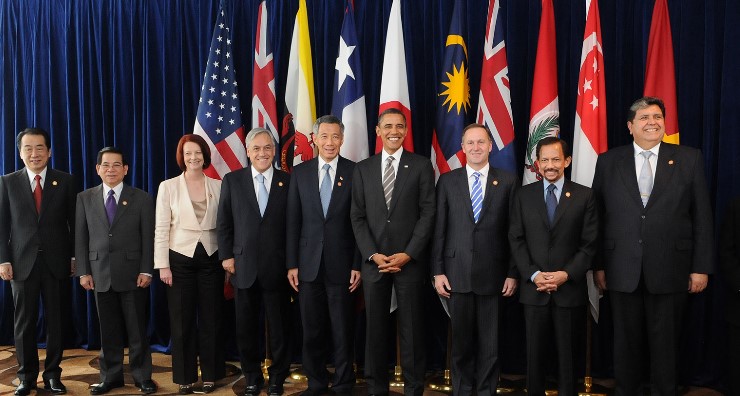Driving commercial and political engagement between Asia, the Middle East and Europe
Driving commercial and political engagement between Asia, the Middle East and Europe
Driving commercial and political engagement between Asia, the Middle East and Europe

Having completed its 19th round of negotiations, the Trans-Pacific Partnership (TPP) remains problematic to negotiators and potential signatories. Originally established in 2006 between Brunei Darussalam, Chile, New Zealand and Singapore, the TPP is now a consortium of 12 nations, including the US and Japan. The proposed plan of the TPP is undeniably of interest to all businesses conducting trade not just in the region, but globally. According to Australian government statistics, if the agreement were to be signed as is, it would comprise of nearly 40 per cent of world GDP and 11.3 per cent of world population. Furthermore, a quarter of world trade would be conducted under the establishment of the TPP.
Bridging four different economic regions in the Asia-Pacific and along the Pacific Rim, the TPP would serve as a stepping stone to achieving the Asia-Pacific Economic Cooperation (APEC) goals of opened trade and integrated economies. Despite having planned to meet on the side-lines of the 2014 World Economic Forum in Davos, Switzerland, members abandoned meetings due to American and Japanese tension. Talks were set to resume in February in Singapore.
As it currently stands, it can be challenging when steering business in the region due to the dense and complex web of trade regulations. Examples such as the ASEAN Free Trade Agreement (AFTA), which allow members to maintain their own tariff schedules and exclusions, and the numerous preferential free trade agreements (PTAs), can be compared to a ‘noodle bowl’ of bilateral agreements, plaguing the region with complexity.
Attempting to untangle the current framework, the objectives of the TPP is to produce a comprehensive agreement which simplifies the numerous PTAs into a succinct arrangement. Liberalising the member economies would be done in a way which can be dubbed as ‘multilateralising regionalism’, where the ultimate goal would be to bring the mess of agreements closer to WTO provisions.
Agreement talks do not come without concern. Realising a fully-functional partnership amid 12 diverse member states can be problematic and domestic complications may delay talks. The US and Japan are both unwilling to settle on currency control, agriculture and food sectors. Concerns over Vietnam and its state-owned enterprises have also brought up issues over licensing, contracts and state finance. From e-commerce to medicines and health, to environmental concerns and agriculture, negotiations go through heated debate with some members adamant in resisting change. Michael Froman, US trade representative dealing with the TPP, claims that all participants have issues that need to be tackled. Therefore prolonged debate on the agreement will continue.
The US in particular has come under fire and criticism. Some argue that allowing the Americans to participate in TPP negotiations favours US interests and their own agenda. The US have pushed for “an investor-state dispute settlement mechanism” that would allow firms to initiate legal processes outside the domestic courts of countries who violate TPP obligations. Intertwining jurisdictional coverage, adjudication and international law may lead to further disagreement. Complicating the situation even further is China’s absence in negotiations. Commentators have argued that this partnership is of commercial irrelevance to the US and is merely a geopolitical exercise veiled by business interests. Chinese official media call out the US for attempting to forge alliances in the already heated region, where both the East and South China Sea disputes remain unsolved. Regardless, Beijing remains cautious when it comes to the possibility of the US corralling regional support to stand opposite the Chinese.
The TPP distinguishes itself from other free trade and preferential agreements as it attempts to liberalise the market of Asia-Pacific with a unique design, scope and purpose. Though no direct involvement exists, the EU will want to closely monitor developments and negotiations coming from the US. Currently, the EU and US are in their own separate process of establishing the Trans-Atlantic Trade and Investment Partnership. The TTIP will further reduce the already low barriers amid the EU and the US, therefore tracking the actions of Washington in South East Asia will be useful.
In March 2013 six British Members of Parliament visited the ASEAN Secretariat in Jakarta. Discussions examined regional trade and integration in both ASEAN and the EU. Though the two frameworks are different, the discussion proved worthy in establishing an understanding and potential learning outcomes for both parties.
It is clear then that this partnership can profoundly impact more than just foreign trade including labour, wage, health and the law. Couple this with concerns over geopolitics and diplomatic motives; the Trans-Pacific Partnership presents itself as a convoluted process that attempts to solve issues of trade that may result in exacerbating vulnerabilities.
Omar Khan is currently doing an internship at Asia House.
